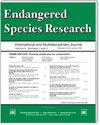Habitat use of the micro-endemic day gecko Phelsuma antanosy in Sainte Luce, Madagascar, and the case for translocation
IF 2.9
2区 环境科学与生态学
Q2 BIODIVERSITY CONSERVATION
引用次数: 0
Abstract
ABSTRACT: The Critically Endangered day gecko Phelsuma antanosy is micro-endemic to 2 humid forest sites in southeastern Madagascar. At one of these, Sainte Luce, it inhabits 4 forest fragments, 2 of which are set to be cleared for mining. Translocation of individuals from within the mining path to protected forest fragments has been proposed to mitigate the impact of habitat loss and the resulting reduction in population size. However, lack of knowledge of its habitat requirements and population structure inhibits efforts to evaluate the likely ecological consequences of translocation. We sampled 92 P. antanosy individuals across each of the known subpopulations in Sainte Luce and assessed the habitat conditions in which they occur, alongside levels of morphological variation. Using 5 morphological trait measures, we found no evidence of subpopulation differentiation. Almost all (>87%) P. antanosy individuals were found on Pandanus longistylus plants and occupancy levels were higher in areas with moderate (30-60%) canopy cover and no other Phelsuma spp. present, suggesting that translocated individuals should be located into these conditions and within a short (<5 m) distance of P. longistylus plants. We propose that siting individuals in patches meeting these criteria may help to maximise translocation efficacy. We discuss our results in the context of the lack of ecological and genetic information on this species, the general need for long-term monitoring of threatened species and the utility of translocation projects to inform and benefit conservation science.马达加斯加 Sainte Luce 小地方性日壁虎 Phelsuma antanosy 的栖息地利用情况和迁移案例
摘要:极度濒危的日壁虎 Phelsuma antanosy 是马达加斯加东南部两个潮湿森林地区的微型特有物种。在其中一个地点--圣卢斯,它栖息在 4 片森林中,其中 2 片森林将被开垦用于采矿。有人建议将采矿区内的个体迁移到受保护的森林片区,以减轻栖息地丧失和种群数量减少造成的影响。然而,由于缺乏对其栖息地要求和种群结构的了解,无法评估迁移可能造成的生态后果。我们在圣路易斯的每个已知亚种群中抽取了 92 个 P. antanosy 个体,评估了它们的栖息地条件以及形态变异水平。通过对5个形态特征的测量,我们没有发现亚种群分化的证据。几乎所有(>87%)P. antanosy个体都是在Pandanus longistylus植物上发现的,在树冠覆盖率适中(30-60%)且没有其他Phelsuma属植物存在的区域,其占有率较高,这表明迁移个体应位于这些条件下,且与P. longistylus植物的距离较短(<5米)。我们建议,将个体安置在符合这些标准的斑块中可能有助于最大限度地提高迁移效果。我们将从缺乏该物种的生态和遗传信息、对濒危物种进行长期监测的普遍需求以及迁移项目在为保护科学提供信息和帮助方面的效用等角度来讨论我们的研究结果。
本文章由计算机程序翻译,如有差异,请以英文原文为准。
求助全文
约1分钟内获得全文
求助全文
来源期刊

Endangered Species Research
BIODIVERSITY CONSERVATION-
CiteScore
5.50
自引率
6.50%
发文量
38
审稿时长
31 weeks
期刊介绍:
ESR is international and interdisciplinary. It covers all endangered forms of life on Earth, the threats faced by species and their habitats and the necessary steps that must be undertaken to ensure their conservation. ESR publishes high quality contributions reporting research on all species (and habitats) of conservation concern, whether they be classified as Near Threatened or Threatened (Endangered or Vulnerable) by the International Union for the Conservation of Nature and Natural Resources (IUCN) or highlighted as part of national or regional conservation strategies. Submissions on all aspects of conservation science are welcome.
 求助内容:
求助内容: 应助结果提醒方式:
应助结果提醒方式:


